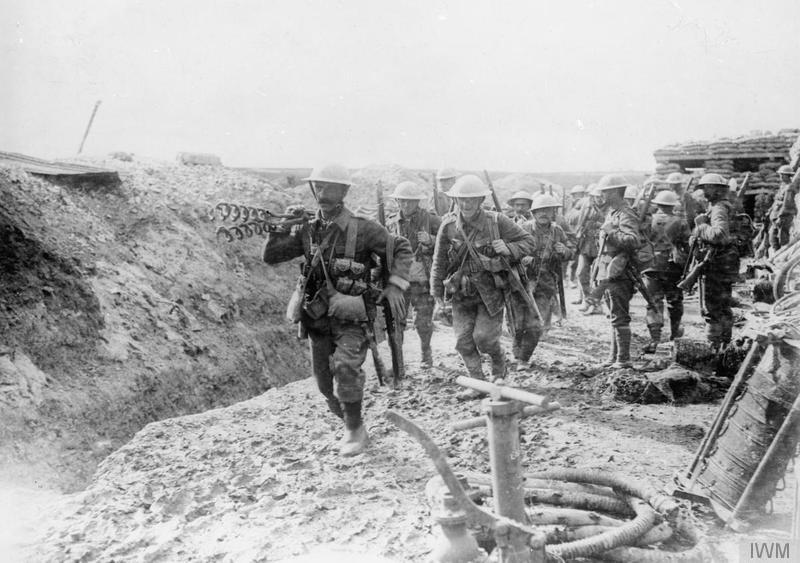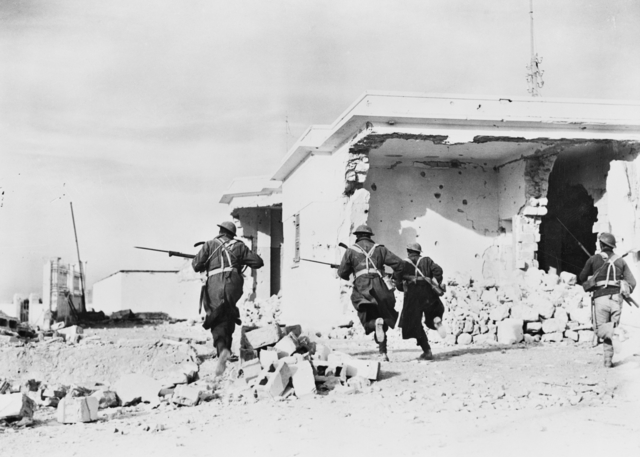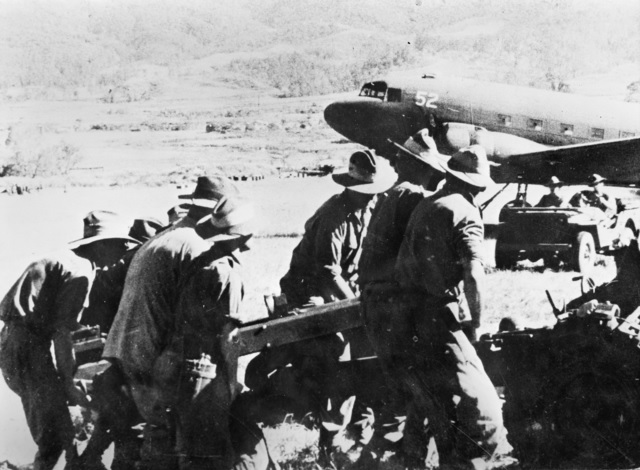|
1st Regiment, Royal Australian Artillery
The 1st Regiment, Royal Australian Artillery is a close support regiment attached to the 7th Brigade at Enoggera Barracks in Queensland. The unit was formed in 1914 under the name 1st Australian Field Artillery Brigade, part of 1st Division Artillery during World War I and later served in World War II and the Vietnam War. It is currently re-equipping with M777A2 lightweight towed howitzers. History World War I The 1st Field Regiment was formed in 1914 following the outbreak of World War I, designated as the "1st Field Artillery Brigade". The brigade saw action on the Gallipoli Peninsula in 1915, supporting the British 29th Division around Cape Helles from early May, and then the Australian 2nd Division around Anzac Cove from October until the force was withdrawn back to Egypt. From mid-1916, the brigade supported the 1st Division on the Western Front until the end of the war in November 1918. During this time, the regiment consisted of the following: the 1st Field Artil ... [...More Info...] [...Related Items...] OR: [Wikipedia] [Google] [Baidu] |
Australian Army
The Australian Army is the principal Army, land warfare force of Australia, a part of the Australian Defence Force (ADF) along with the Royal Australian Navy and the Royal Australian Air Force. The Army is commanded by the Chief of Army (Australia), Chief of Army (CA), who is subordinate to the Chief of the Defence Force (Australia), Chief of the Defence Force (CDF) who commands the ADF. The CA is also directly responsible to the Minister of Defence (Australia), Minister for Defence, with the Department of Defence (Australia), Department of Defence administering the ADF and the Army. Formed in 1901, as the Commonwealth Military Forces, through the amalgamation of the colonial forces of Australia following the Federation of Australia. Although Australian soldiers have been involved in a number of minor and major conflicts throughout Australia's history, only during the Second World War has Australian territory come under direct attack. The Australian Army was initially composed a ... [...More Info...] [...Related Items...] OR: [Wikipedia] [Google] [Baidu] |
29th Division (United Kingdom)
The 29th Division, known as the ''Incomparable Division'', was an infantry division of the British Army, formed in early 1915 by combining various Regular Army units that had been acting as garrisons around the British Empire. Under the command of Major-General Aylmer Hunter-Weston, the division fought throughout the Gallipoli Campaign, including the original landing at Cape Helles. From 1916 to the end of the war the division fought on the Western Front in Belgium and France. According to the published divisional history (see reference below), 'The total casualties of the 29th Division amounted to something like 94,000. Gallipoli alone accounted for 34,000. This must be, if not a record, among the highest totals in any division … The number of Victoria Crosses won by members of this division was 27 (12 at Gallipoli). This constitutes a record'. A large commemorative Portland stone obelisk, built in 1921 to remember the Division's review by King George V before they were sent ... [...More Info...] [...Related Items...] OR: [Wikipedia] [Google] [Baidu] |
Battle Of Bardia
The Battle of Bardia was fought between 3 and 5 January 1941, as part of Operation Compass, the first British military operation of the Western Desert campaign of the Second World War. It was the first battle of the war in which an Australian Army formation took part, the first to be commanded by an Australian general and the first to be planned by an Australian staff. The 6th Australian Division (Major General Iven Mackay) assaulted the strongly held Italian fortress of Bardia, Libya, assisted by air support and naval gunfire and under the cover of an artillery barrage. The 16th Australian Infantry Brigade attacked at dawn from the west, where the defences were known to be weak. Sappers blew gaps in the barbed wire with Bangalore torpedoes and filled in and broke down the sides of the anti-tank ditch with picks and shovels. This allowed the infantry and 23 Matilda II tanks of the 7th Royal Tank Regiment to enter the fortress and capture all their objectives, along with 8,000 ... [...More Info...] [...Related Items...] OR: [Wikipedia] [Google] [Baidu] |
Australian 6th Division
The 6th Division was an infantry division of the Australian Army. It was raised briefly in 1917 during World War I, but was broken up to provide reinforcements before seeing action. It was not re-raised until the outbreak of World War II, when it was formed as a unit of the Second Australian Imperial Force (2nd AIF). Throughout 1940–41 it served in the North African Campaign, the Greek campaign, on Crete and in Syria, fighting against the Germans, Italians and Vichy French. In 1942, the division left the Middle East and returned to Australia to meet the threat of Japan's entry into the war. Part of the division garrisoned Ceylon for a short period of time, before the division was committed to the New Guinea campaign. In New Guinea, its component brigades had a major role in the successful counter-offensive along the Kokoda Track, at Buna–Gona and around Salamaua–Lae in 1942–43. Throughout late 1943–44, the division was re-organised in Australia before being committed ... [...More Info...] [...Related Items...] OR: [Wikipedia] [Google] [Baidu] |
Ingleburn, New South Wales
Ingleburn is a suburb of Sydney, in the state of New South Wales, Australia 40 kilometres south-west of the Sydney central business district, in the Local government in Australia, local government area of City of Campbelltown (New South Wales), City of Campbelltown. It is part of the Macarthur, New South Wales, Macarthur region. Ingleburn is located approximately halfway between the two commercial centres of Liverpool, New South Wales, Liverpool and Campbelltown, New South Wales, Campbelltown. History The land in the Ingleburn area was originally inhabited by the Tharawal people prior to the arrival of settlers from the First Fleet in 1788. The first land grants in the area were made in 1809 to William Neale, Joshua Alliot, all previously soldiers in the NSW Corps. As such, the area became known as "Soldier Flat". In 1869, a rail platform was built on the old Neale grant and given the name Macquarie Fields Station after a property to the north. However, in 1881 the Macquarie ... [...More Info...] [...Related Items...] OR: [Wikipedia] [Google] [Baidu] |
2/1st Field Regiment (Australia)
The 2/1st Field Regiment was an Australian Army artillery regiment raised as part of the all volunteer Second Australian Imperial Force during World War II. Formed in October 1939, the regiment was assigned to the 6th Division. Shortly after it was raised, the regiment was deployed to the Middle East, where it was briefly re-roled as an anti-aircraft regiment before returning to the field artillery role. In 1941, the regiment served in North Africa and in Greece, before being withdrawn back to Australian in early 1942, following Japan's entry into the war. In late 1942, and early 1943, the regiment took part in the defence of Port Moresby during the fighting along the Kokoda Track, before taking part in the Battle of Buna–Gona and the defence of Wau, remaining in New Guinea on garrison duties until August 1943. Withdrawn to Australia, a long period of training followed before the regiment took part in its final campaign of the war Aitape–Wewak campaign in 1945. History ... [...More Info...] [...Related Items...] OR: [Wikipedia] [Google] [Baidu] |
Second Australian Imperial Force
The Second Australian Imperial Force (2nd AIF, or Second AIF) was the name given to the volunteer expeditionary force of the Australian Army in the Second World War. It was formed following the declaration of war on Nazi Germany, with an initial strength of one infantry division and related auxiliary components. After considerable expansion of this force, three divisions were sent to the Middle East and North Africa, while the 8th Division was sent to garrison British Malaya and Singapore. Under the ''Defence Act 1903'', neither the part-time Militia nor the full-time Permanent Military Force (PMF) could serve outside Australia or its territories unless they volunteered to do so. The Second AIF fought against Nazi Germany, Italy, Vichy France and Japan. After the war, Australia's wartime military structures were demobilised and the 2nd AIF was disbanded, although a small cadre of its personnel became part of the Interim Army that was established in 1947, and from which the Austra ... [...More Info...] [...Related Items...] OR: [Wikipedia] [Google] [Baidu] |
Australian Army Reserve
The Australian Army Reserve is a collective name given to the reserve units of the Australian Army. Since the Federation of Australia in 1901, the reserve military force has been known by many names, including the Citizens Forces, the Citizen Military Forces, the Militia and, unofficially, the Australian Military Forces. In 1980, however, the current name—Australian Army Reserve—was officially adopted, and it now consists of a number of components based around the level of commitment and training obligation that its members are required to meet. Overview For the first half of the 20th century, due to a widespread distrust of permanent military forces in Australia, the reserve military forces were the primary focus of Australian military planning.Grey 2008, pp. 66–83. Following the end of World War II, however, this focus gradually shifted due to the changing strategic environment, and the requirement for a higher readiness force available to support collective security g ... [...More Info...] [...Related Items...] OR: [Wikipedia] [Google] [Baidu] |
Australian 1st Field Artillery Battery
1st Field Artillery Battery was formed in August 1914 in New South Wales from 1st, 2nd and 3rd Royal Australian Field Artillery batteries of the regular army and assigned to 1st Field Artillery Brigade. 1st Battery departed for Egypt on 18 October 1914, the battery saw action in Egypt, Sinai Sinai commonly refers to: * Sinai Peninsula, Egypt * Mount Sinai, a mountain in the Sinai Peninsula, Egypt * Biblical Mount Sinai, the site in the Bible where Moses received the Law of God Sinai may also refer to: * Sinai, South Dakota, a place ... and the Western Front. References Further reading * 1 Military units and formations established in 1914 1914 establishments in Australia {{Australia-mil-stub ... [...More Info...] [...Related Items...] OR: [Wikipedia] [Google] [Baidu] |
Western Front (World War I)
The Western Front was one of the main theatres of war during the First World War. Following the outbreak of war in August 1914, the German Army opened the Western Front by invading Luxembourg and Belgium, then gaining military control of important industrial regions in France. The German advance was halted with the Battle of the Marne. Following the Race to the Sea, both sides dug in along a meandering line of fortified trenches, stretching from the North Sea to the Swiss frontier with France, which changed little except during early 1917 and in 1918. Between 1915 and 1917 there were several offensives along this front. The attacks employed massive artillery bombardments and massed infantry advances. Entrenchments, machine gun emplacements, barbed wire and artillery repeatedly inflicted severe casualties during attacks and counter-attacks and no significant advances were made. Among the most costly of these offensives were the Battle of Verdun, in 1916, with a combined 700,000 ... [...More Info...] [...Related Items...] OR: [Wikipedia] [Google] [Baidu] |
1st Division (Australia)
The 1st Division is headquartered in Enoggera, a suburb of Brisbane. The division was first formed in 1914 for service during World War I as a part of the Australian Imperial Force (AIF). It was initially part of the Australian and New Zealand Army Corps (ANZAC) and served with that formation during the Gallipoli campaign, before later serving on the Western Front. After the war, the division became a part-time unit based in New South Wales, and during World War II it undertook defensive duties in Australia before being disbanded in 1945. After World War II, the division remained off the Australian Army's order of battle until the 1960s, when it was reformed in New South Wales. In 1965 it adopted a certification role, determining the operational readiness of units deploying to Vietnam. It was re-formed in 1973 as a full division based in Queensland and in the decades that followed it formed the Australian Army's main formation, including both Regular and Reserve personnel. Th ... [...More Info...] [...Related Items...] OR: [Wikipedia] [Google] [Baidu] |





